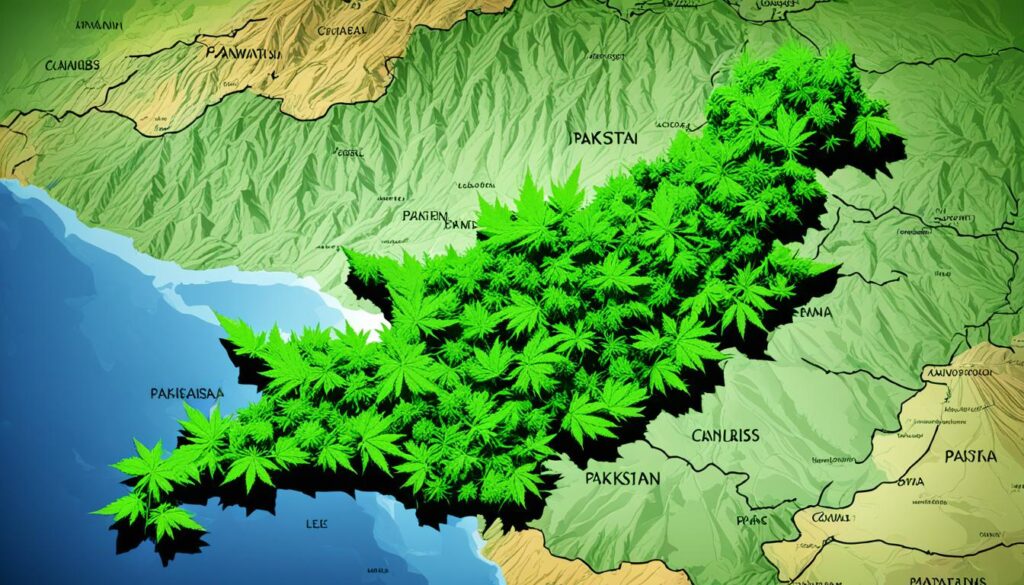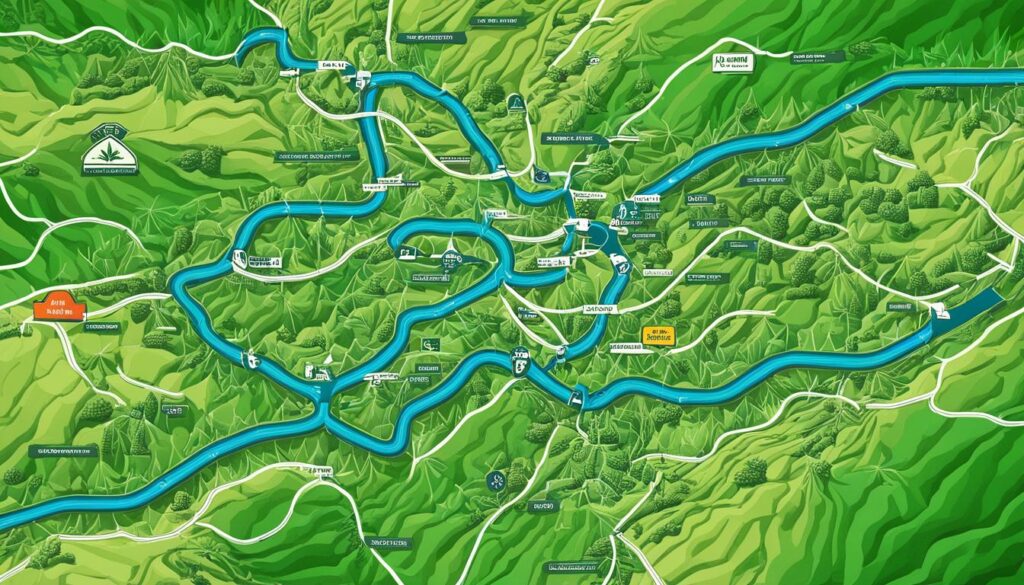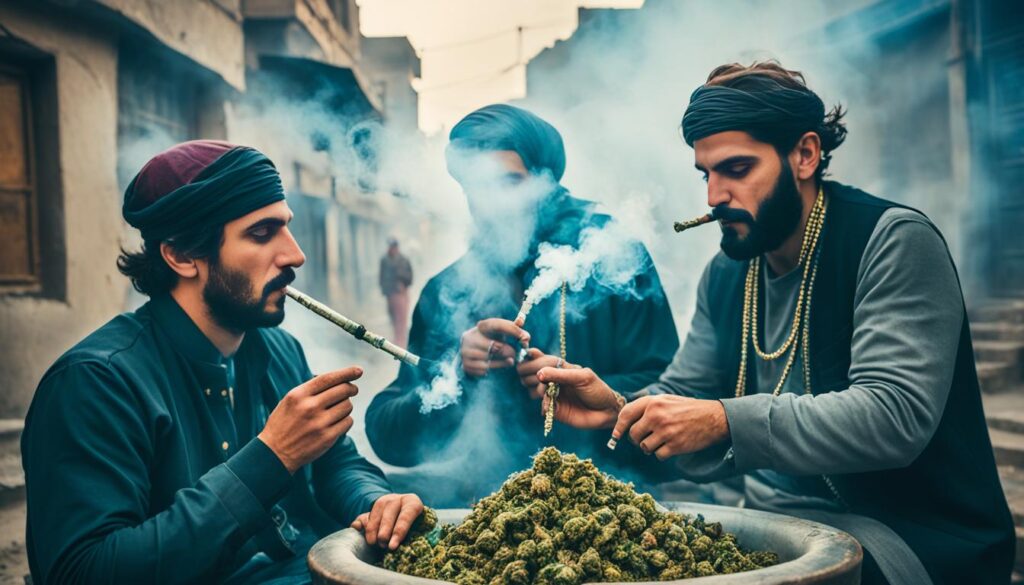Peshawar is a city in Pakistan known for its weed. It has a long history with cannabis. This city is a key place for weed lovers. We will look into the world of weed in Peshawar, including its culture, laws, and new trends.
Key Takeaways
- Peshawar is a major hub for cannabis consumption in Pakistan, with an estimated 6.4 million people using the drug in various forms.
- The Peshawar Valley in Pakistan is known for producing high-quality cannabis strains, including the potent “Peshawar strain” with a strong, electric high.
- Cannabis cultivation and trade in Pakistan are largely illegal, but the government has recently taken steps to legalize hemp production for economic and industrial purposes.
- Peshawar’s strategic location along historic drug trafficking routes has contributed to the city’s reputation as a hub for the illegal marijuana trade.
- The region’s unique genetic heritage, including the Nuristan population and the Khyber Sativa landrace, has made Peshawar a focal point for cannabis enthusiasts and researchers.
The History of Cannabis in Pakistan
Before the British and American governments came, cannabis was very important in Central Asia. It was one of the five sacred plants in the Atharvaveda text. People used it for medicine, making clothes, and for fun.
In the 20th century, things changed. The Control of Narcotics Substance Act of 1997 made it illegal to make, sell, or give out the drug. But, it was okay for medical, scientific, or industrial use.
Pre-British and American Influence
Cannabis has a long history in Pakistan, going back to ancient times. It was a big part of traditional life. People used it for medicine, making clothes, and spiritual reasons.
A 1983 report showed that drug use in Pakistan was steady from the 1950s to the 1970s. But, cannabis use went up in the late 1960s and early 1970s. This was because of Western culture’s influence.
| Timeframe | Cannabis Usage Trend in Pakistan |
|---|---|
| Pre-1950s | Cannabis was widely used for medicinal, textile, and spiritual purposes |
| 1950s-1970s | Drug usage remained relatively stable |
| Late 1960s-Early 1970s | Uptick in cannabis use due to Western pop culture influence |
| 1997 onwards | Possession and distribution of cannabis became illegal, except for medical, scientific, or industrial purposes |
The British and American influence and global drug policies changed cannabis in Pakistan. Now, the country is trying to understand its deep connection with the plant. This is important for the future.
weed in Peshawar: The Current Landscape
Peshawar is a city in Pakistan’s Khyber Pakhtunkhwa province. It’s known for its cannabis use. Even though the government tries to stop drug trade, weed is still big in the local culture. In tribal areas, you can even buy it openly in markets.
In Peshawar, weed is big in the culture. People can get it from dealers or big networks. This has made weed a big part of fun and social events.
More women in Peshawar are using weed now. This is changing old ideas about who uses it. It shows weed use is changing and we need to think differently about it.
Weed is easy to find in Peshawar, even though it’s illegal. People accept it a lot, so the police don’t really care. This makes Peshawar a key place for cannabis consumption in Pakistan. It shows how complex the local weed culture is.
| Indicator | Peshawar | National Average |
|---|---|---|
| Cannabis Consumption Rate | 35% | 20% |
| Availability of Weed | High | Moderate |
| Public Acceptance | Relatively High | Relatively Low |
The table shows how Peshawar is different from the rest of Pakistan. More people use weed here, and it’s easy to find. This shows how deep weed use is in the culture and the big challenge in dealing with drugs here.
“The personal use of cannabis in Peshawar has become so normalized that it is often overlooked by the authorities, despite the ongoing efforts to curb the drug trade.”
Legal Status and Recent Developments
Legalization of Hemp Production
In September 2020, Pakistan made a big move. They legalized hemp production. This move was because Pakistan has a lot of cannabis and it could make a lot of money from it.
They could make over $1 billion from hemp and other cannabis products. But, people can’t use cannabis for fun in Pakistan yet.
Legalizing hemp is a good start. But we need to look at the big picture of cannabis laws. Some places like Antigua and Barbuda let people use cannabis for fun.
Belgium also lets people have a little cannabis for personal use. They can have up to 3 grams or grow one plant.
Uruguay was the first country to make cannabis legal for everyone in 2013. They started selling it in 2017. Australia followed in 2019, letting people grow two plants and have up to 50 grams.
Some countries also made medical cannabis legal. This includes places like Argentina, Canada, and Germany. In the U.S., 38 states and the District of Columbia allow medical cannabis, but not the whole country.
As more countries look at legalizing cannabis, Pakistan is watching closely. They see the chance to make a lot of money. But, they also have to think about the rules and how it affects people.

Cannabis Trade and Trafficking Networks
Peshawar is a key spot near the Afghan border. It’s a big center for the marijuana trade and drug networks in Pakistan. This city is where cannabis from Afghanistan comes in. Then, it spreads all over Pakistan and even goes to other countries.
Afghanistan makes about 85 percent of the world’s opium. This has made it a big source of cannabis for Pakistan. More and more poppy fields grew there from 2002 to 2020. This has helped the drug trade grow and given jobs to many people.
Back in the 1960s and 70s, people in the West loved Afghan hashish. We don’t have exact numbers on how much cannabis Afghanistan grows. But, it’s a big part of the income for many families in the countryside.
The Taliban banned poppy and drugs, but drug trafficking didn’t stop. Pakistan and Iran catch most of the world’s opium. The movement of people and goods between these countries helps keep the drug trade alive.
Afghanistan, Pakistan, and Iran meet in a region known as the Golden Crescent. It’s famous for drug smuggling. Central Asia is also a key path for drugs to Russia and Europe. Tajikistan is very important in this route.
“Western policymakers are urged to expand counter-narcotics toolkits beyond law enforcement to build domestic public pressure for accountable counter-narcotics regimes. International counter-narcotics assistance should support partnerships with local organizations to address corruption and collusion in tackling drug trafficking networks.”

The cannabis and opium trades in Afghanistan are closely linked. This shows we need a wide-ranging plan to fight drug trafficking. Working together, local, national, and international groups can help stop the big drug trade in Peshawar.
Conclusion
Peshawar’s story with cannabis is complex and deep. It’s shaped by history, geography, and policy changes. Even though using weed for fun is still illegal in Pakistan, growing hemp is now legal. This opens up new economic chances for the area.
As weed trade and networks change, it’s important to understand Peshawar’s weed scene. This is key for those making laws, police, and everyone else. Data shows farmers in Peshawar face big challenges like lower yields and weed problems.
The future of Peshawar and cannabis is still up in the air. With parthenium weed and its natural enemy spreading, we need to tackle these issues. The summary of weed in Peshawar tells us we need more research and better policies. Working together is crucial for the future outlook of weed in this changing area.

As a veteran weed smoker for over 30 years and been very clean for the last 3 years, I have been craving it.
One thing I’ve never done is consume it?
I came across SunJet Plug and thought mmmm how esp with legalities etc.
So I made the plunge and purchased 12 brownies, well within 30 mins it kicked in and it was immense as I had a whole one from the off 😜
The rest did not last a week I was having 2 a day and my wife lost me for a few days I was in my own world apparently.
Kudos to the Sunjet plug love em, the taste is a bit undesirable could do with a tweak or two other than that no complaints
Contact him on his telegram link: t.me/sunjetplug
His email : sunjetplug@gmail.com
Many many thanks.😁
Take note ,he does not have telegram channels
Sunjet plug is 100% legit.. I’m a repeat customer.. I’ve ordered 10+ times now, and I’ve never had an issue.. Great product, great service.
Sunjet plug is extremely trust worthy , they never fail in what ever product I order, and its always in my hands with an hour of ordering 99% of the time….. its honestly rare when its more than 2 hours and that’s only because its the weekend when ive orded or a national holiday is on or something lol …. brilliant service I’m probably pushing maybe 2 months with them and I’ve never been disappointed ❤️ my only recommendation would maybe do a stamp card to get something free after 5 orders or a loyalty bonus of some kind ❤️
Email sunjet.. sunjetplug@gmail.com